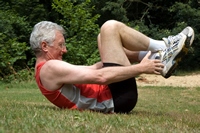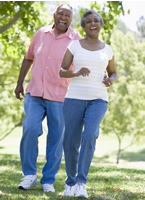Exercise After Stroke

Physical activity or exercise can be any activity that gets the body moving. This includes things like walking and dancing. It can even include household chores like sweeping.
Why Is It Important?
Exercise is good for both the mind and body. It can help your loved one get back strength that was lost due to stroke. It can make muscles more flexible. This will help improve how your loved one moves.
Physical exercise is important in reducing the risk of your loved one having another stroke. Stroke guidelines suggest that the survivor gets 20 to 60 minutes of aerobic exercise three to seven days per week. To make it easier, the exercise can be broken into smaller times. Walking for 10-15 minutes several times a day is a good way to get aerobic exercise.
Physical benefits of exercise:
- Improves energy level
- Makes bones and muscles stronger
- Lowers blood pressure
- Helps improve sleep
- Improves flexibility
- Reduces risk of falls
- Lowers chance of another stroke
Mental benefits ofexercise:
- Reduces stress
- Lowers feelings of depression and anxiety
- Improves self-worth
- Promotes independence
What Do You Need to Know?
Stroke can reduce your loved one’s ability to exercise. If they are depressed, the motivation to exercise may be lowered. With decreased physical activity, muscles become weaker. The chances of another stroke or other health problem will increase.
It is important for your loved one to get regular exercise. Most survivors are able to do some form of exercise after their stroke. The type of exercise your loved one can do depends on the disability. The key is to stay as physically active as possible. Talk to your healthcare team before your loved one starts an exercise program.
What Are the Different Types of Exercise?
Aerobic Exercise
- Includes walking, dancing or riding a bike
- Helps to lower blood pressure and maintain a healthy body weight
- Low-impact exercises like swimming help protect the joints
Do 30 minutes of moderate exercise 5 days a week or 20 minutes of intense exercise 3 days a week.
Strengthening Exercise
- Includes conditioning exercises, like sit-ups and push-ups
- Includes using balance balls and weights
- Helps to make muscles stronger
Do muscle strengthening exercises at least two times a week.
Flexibility Exercise
- Includes stretching and yoga
- Helps to keep joints flexible
- Lowers chance of injury
Do exercises that increase flexibility at least 2 times a week.
|
Red Flag: Signs to Stop Exercising 
Stop exercising right away and contact your healthcare team if your loved one:
|
How Do You Get Your Loved One to Exercise?
- Help your loved one choose activities they enjoy doing. Walking the dog or gardening can be a fun way to get exercise.
- Join in on the exercise. You can improve your health together.
- Be a cheerleader for your loved one. Even small progress deserves praise.
- Keep an activity journal. Seeing the progress made can help motivate your loved one to continue. You can use the activity journal on My HealtheVet. You must be registered to use this feature.
- Look into adaptive recreation if your loved one has a disability. Adaptive recreation allows people with disabilities to get involved in sports or other fitness activities. The Adaptive Resource Information Center can help you find activities in your area. The Resources section has contact information.
Helpful Tips
- Have your loved one start slowly. Don’t overdo it.
- Remember to have them warm up and cool down when exercising.
- Make sure your loved one drinks plenty of water before, during and after exercise.
Remember
- Exercise is important in reducing the risk of your loved one having another stroke. It is good for both the mind and body.
- Talk to your healthcare team before your loved one starts exercising.
- Exercise with your loved one and improve your health too.
More Resources 
Additional credible resources on this topic can be found here. Website pages may change or update, therefore if a link does not work, you may also try to type the information into your internet search bar. This Resource List will be updated frequently.
References: National Stroke Association. (2008). Hope: The Stroke Recovery Guide. Retrieved August 19, 2008, from: https://www.stroke.org/-/media/Stroke-Files/life-after-stroke/ASA_HOPE_Stroke_Recovery_Guide_122020.pdf*; American Council on Exercise. (2008). Fit Facts. Retrieved October 8, 2008, from: http://www.acefitness.org/fitfacts/default.aspx*; Caswell, J. (2008) Getting Active, Staying Active: Even a little physical activity has far-reaching benefits for stroke survivors. Stroke Connection, pg 15-18.; About.com. (2008). Retrieved October 8, 2008, from: http://exercise.about.com*; My HealtheVet. (2008). Healthy Living Centers. Retrieved October 8, 2008, from: http://www.myhealth.va.gov; Morantz, C. and Torrey, B. (July 15, 2004). Practice Guideline Briefs: Recommendations for exercise after stroke. American Family Physician. Retrieved November 12, 2008, from: http://www.aafp.org/afp/20040715/practice.html; Nelson, Miriam E., W. Jack Rejeski, Steven N. Blair, Pamela W. Duncan, James O. Judge, Abby C. King, Carol A. Macera, and Carmen Castaneda-Sceppa. (2007). “Physical Activity and Public Health in Older Adults.”Circulation.116; 1094-1105. Retrieved November 16, 2008, from http://circ.ahajournals.org/cgi/content/full/109/16/2031*.
These materials were created for the project:
Web-Based Informational Materials for Caregivers of Veterans Post-Stroke
Project Number SDP 06-327 funded by VA HSR&D Quality Enhancement Research Initiative (QUERI)



















